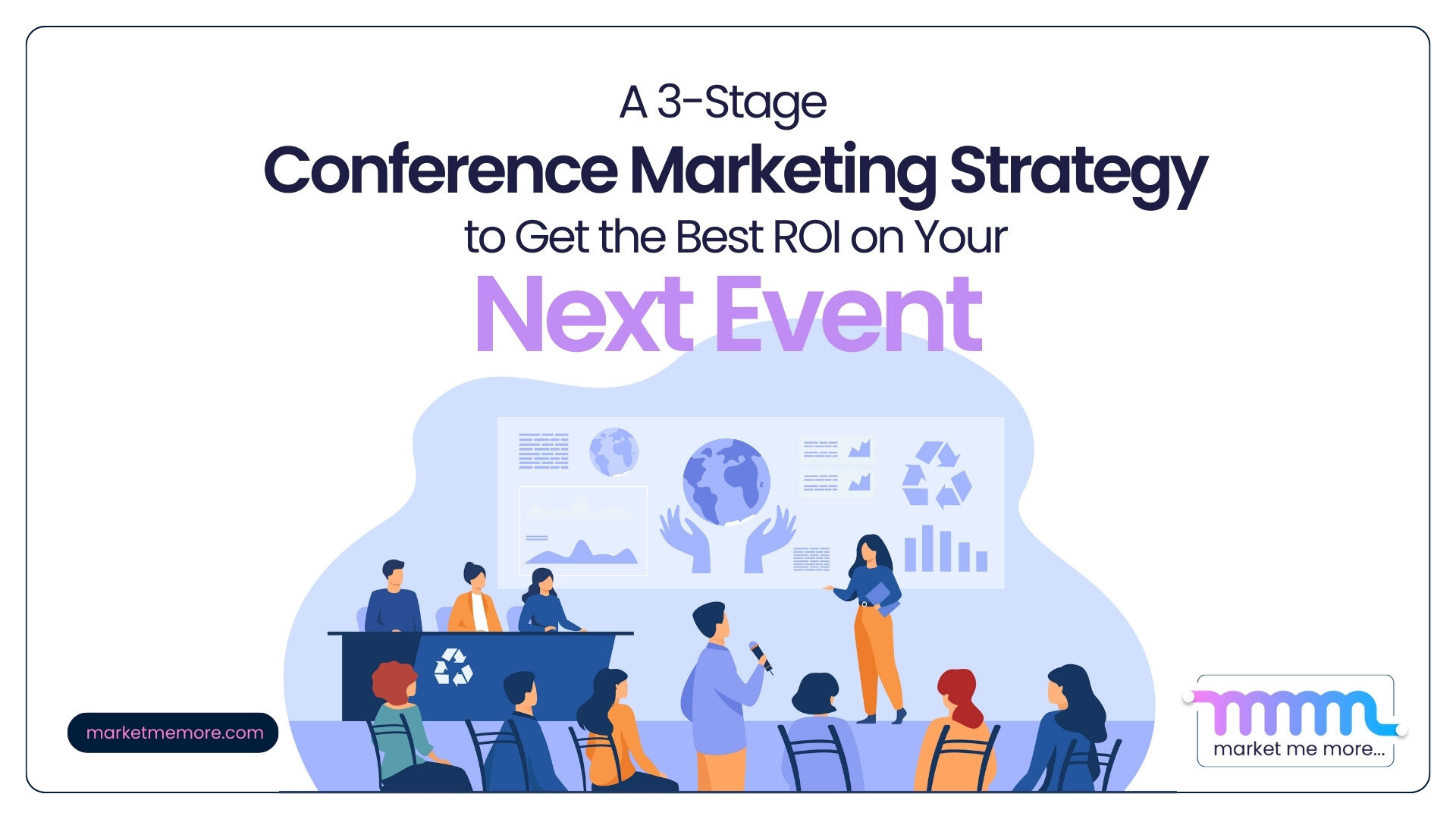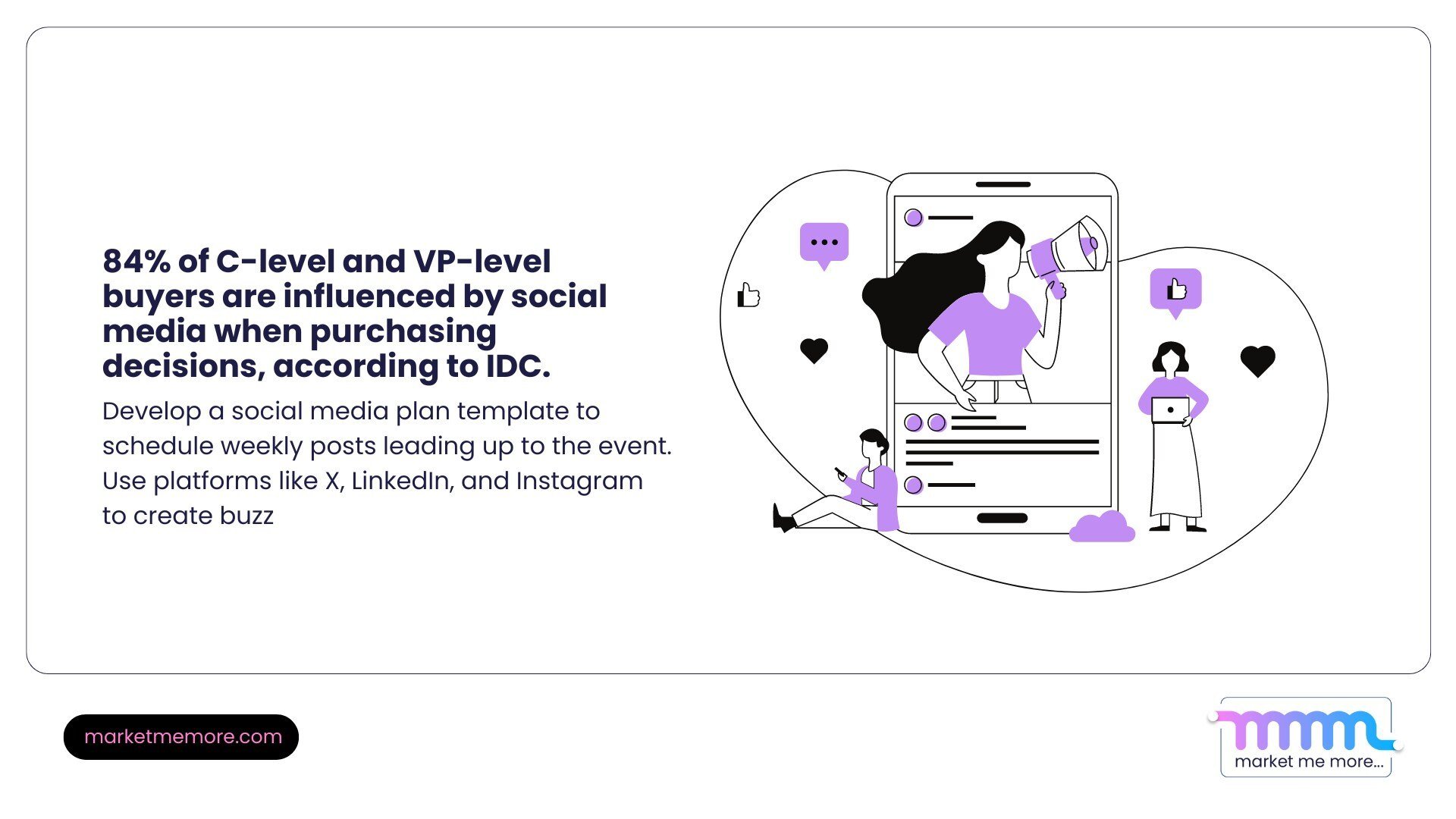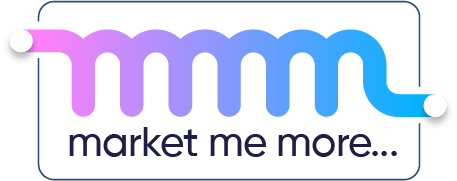A 3-Stage Conference Marketing Strategy to Get the Best ROI on Your Next Event

Over the last few years, we’ve interacted with numerous business owners at industry events. This experience has shown us that there’s a clear divide in how organizations value conferences.
For some, conferences are a goldmine for brand awareness and lead generation. For others, they’re seen as a costly gamble with uncertain returns.
Given that companies can spend anywhere from $500 to over $100,000 on conferences, this divide is understandable.
If you’re merely attending a conference, you can keep costs relatively low.
However, if you plan to have a booth, sponsor an after-party, or secure a keynote slot, expenses can escalate rapidly.
This raises the question:
How can some organizations justify such high spending while others hesitate to commit even a small amounts? The answer lies in having a comprehensive and effective conference marketing strategy.
At Market Me More, we’ve created an internal 3-stage approach to conference marketing that ensures you not only make a splash at the event but also see a significant return on your investment. Let’s dive into the details.
Stage 1: Pre-Conference Planning
The success of your conference efforts begins long before you arrive at the venue. Proper planning can set the stage for meaningful interactions, effective networking, and ultimately, better ROI.
1. Get a Comprehensive List of Attendees
- Research and Verification: Start by obtaining the full list of attendees. Most conferences provide this list through their event app or website. Take the time to verify that the information is up-to-date and accurate.
- Segment and Prioritize: Not every attendee will be relevant to your goals. Segment the list based on criteria like industry, job role, and company size, and prioritize those that align closely with your target audience.
2. Identify and Schedule Meetings with Key Prospects
- LinkedIn Sales Navigator: Leverage tools like LinkedIn Sales Navigator to dig deeper into the profiles of the attendees. This will allow you to filter prospects based on various criteria and find individuals who fit your ideal customer profile (ICP).
- Multi-Channel Outreach: Begin reaching out to these individuals via email, LinkedIn, and other social media platforms. 4 out of 5 marketers personalize emails with profile data and 64% personalize them by segment.
- Pre-Schedule Meetings: Don’t wait until the conference to set up meetings. Aim to have at least 20 meetings pre-scheduled for each team member attending. This ensures that your time at the conference is spent efficiently.
3. Build Pre-Event Buzz
- Content Creation: Start creating content that highlights your participation in the conference. This could be in the form of blogs, social media posts, or even short video teasers. 86% of B2B marketers report that their organizations are using content marketing, and 70% of them are creating more content than they did one year ago.
- Social Media Campaigns: Develop a social media plan template to schedule weekly posts leading up to the event. Use platforms like X, LinkedIn, and Instagram to create buzz. Remember, 84% of C-level and VP-level buyers are influenced by social media when purchasing decisions, according to IDC.

4. Strategize Off-Hours Networking
- Scout the Scene: Identify popular bars, restaurants, and lounges near the conference center. Often, the most valuable connections are made in informal settings where attendees are more relaxed.
- Host a Private Gathering: Consider hosting a small, invite-only gathering at one of these venues. This will enhance your brand’s visibility and provide a platform for more in-depth conversations.
5. Prepare Your Digital Toolkit
- Landing Page with an Offer: Create a dedicated landing page that includes a special offer, such as a free eBook, whitepaper, or a trial service. Link this page to a QR code that you can distribute during the event.
- Modern Contact Sharing: Move away from traditional business cards. Instead, use digital methods like iPhone’s AirDrop, NFC-enabled business cards, or RFID cards. Not only does this approach make sharing details more efficient, but it also helps you stand out.
6. Optimize Your CRM for Conference Leads
- Lead Tagging and Tracking: Before the event, ensure your CRM is set up to tag and track conference-specific leads. According to Salesforce, companies that use CRM systems see sales increase by up to 29%, highlighting the importance of proper lead management.
- Automation and Integration: Utilize automation tools to integrate conference leads into your existing sales funnel. This ensures timely follow-ups and personalized communication.
Stage 2: Conference Activities
Once the event is underway, your focus shifts to maximizing your presence and making every interaction count. The goal here is to stand out and create lasting impressions.
1. Design a Standout Booth
- Think Outside the Box: Your booth should be more than just a table with some banners. Consider interactive elements like digital screens, VR experiences, or live product demonstrations. According to a study by Freeman, 98% of attendees feel more inclined to buy a product after participating in an engaging experience at a booth.
- Brand Consistency: Ensure that your booth’s design aligns with your brand’s colors, messaging, and overall aesthetic. Consistency is key to building brand recognition.

2. Personal Branding and Visibility
- Be Recognizable: Wearing unique branded apparel, such as a custom t-shirt or a distinctive hat, can make you more memorable. A study by the Event Marketing Institute found that 74% of event attendees have a more positive opinion of a brand after interacting with employees who wear branded clothing.
- Interactive Swag: Give away branded items that are not just useful but also interactive. Think along the lines of QR code-embedded notebooks or USB drives loaded with your company’s presentations or case studies.
3. Distribute High-Impact Brochures
- Quality over Quantity: Instead of handing out generic brochures to everyone, focus on giving well-designed, relevant materials to qualified leads. A study by FedEx Office found that 76% of small business owners find that well-designed marketing materials significantly impact their business’s success.
- Incorporate Technology: Include a QR code or NFC tag in your brochures that leads to a personalized landing page, offering additional resources tailored to the recipient’s interests.
4. Deep Engagement with Attendees
- Meaningful Conversations: Move beyond the sales pitch. Ask insightful questions about their business challenges and listen attentively. According to Harvard Business Review, organizations that master consultative selling outperform their peers by up to 10%.
- Document Interactions: Use a digital notepad or a CRM app to jot down key details about each interaction. This will help you tailor your follow-up strategy and personalize future communications.
5. Maximize Keynote Opportunities
- Strategic Seating: If multiple team members are attending, assign them to different tables during keynotes. This maximizes your network reach and provides diverse perspectives from the event.
- Personalized Speaker Outreach: Handwritten notes with your branding can be powerful. After a speaker concludes their session, approach them with a thoughtful note and your contact details. This simple act can leave a lasting impression, leading to potential future collaborations.
Stage 3: Post-Conference Activities
The post-conference phase is where your efforts should come to fruition. It’s time to leverage the relationships you’ve built and turn them into tangible results.
1. Publish Conference Lessons
- Blog Recap: Write a detailed blog that covers your key takeaways from the conference. Not only does this establish your thought leadership, but it also provides value to your audience. According to HubSpot, businesses that blog generate 67% more leads than those that don’t.
- Email Distribution: Share this blog with your entire email list, including those you met at the conference.
2. Immediate Follow-Up
- Personalized Emails: Send a personalized follow-up email to each person you met at the conference. Refer back to your conversation to demonstrate that you were genuinely interested. According to McKinsey, email is 40 times more effective at acquiring new customers than social media.
- Calendly Integration: Include a link to schedule a follow-up call. Tools like Calendly can streamline this process, allowing recipients to choose a time that works best for them.
3. Align with Your BDR Team
- Warm Call Strategy: Share your conference insights with your Business Development Representatives (BDRs) to help them craft warm call strategies. Research by RAIN Group shows that warm calls result in conversations 30% of the time, compared to just 1-3% for cold calls.
- Leverage CRM Data: Ensure all conference leads are fully integrated into your CRM, with detailed notes on each interaction. This will help your BDRs make more informed calls and follow-ups.
4. Nurture Leads with Tailored Content
- Segmented Drip Campaigns: Create segmented email drip campaigns based on the interests and needs of your conference leads. According to DMA, segmented and targeted emails generate 58% of all revenue.
- Content Personalization: Send relevant whitepapers, case studies, or blog posts that align with the specific interests of each lead. Personalization can increase conversion rates by up to 10%, according to Econsultancy.
5. Build Long-Term Relationships
- Plan Future Collaborations: Maintain regular contact with your conference connections by planning joint webinars, co-branded content, or even future conference attendance together.
- Co-host Events: Suggest co-hosting a webinar or a live event with some of your top connections from the conference. This collaboration not only strengthens the relationship but also exposes your brand to a broader audience. According to the Content Marketing Institute, 62% of B2B marketers use webinars as part of their content marketing strategy, making it a powerful tool for lead generation.
- Regular Check-ins: Don’t let the relationship fizzle out after the initial follow-up. Schedule regular check-ins via email or LinkedIn. This ongoing engagement helps keep your brand top of mind when they are ready to make a purchasing decision.
.jpg?width=1920&height=1080&name=Inline%20image%202%20(2).jpg)
Stage 4: Bonus Tips for Maximizing ROI
While the 3-stage approach provides a solid framework, incorporating additional tactics can further boost your ROI. Here are some bonus tips to consider:
1. Leverage Social Proof and Testimonials
- Capture Testimonials on Site: During the conference, take the opportunity to gather testimonials from satisfied customers or partners who are attending. You can do this through short video interviews or written quotes. According to Nielsen, 92% of consumers trust recommendations from individuals (even if they don’t know them) over brands.
- Showcase Success Stories: Highlight these testimonials in your post-conference content, such as blog posts, social media posts, and follow-up emails. This social proof can be incredibly persuasive for potential clients considering your services.
2. Use Advanced Analytics
- Track Engagement Metrics: Use analytics tools to track how your content (blogs, social media posts, emails) is performing among conference attendees. Metrics like open rates, click-through rates, and time spent on page can provide valuable insights into what’s resonating with your audience.
- ROI Calculation: Calculate the ROI of your conference participation by comparing the costs against the leads generated and their potential value.
3. Invest in High-Quality Visual Content
- Professional Photography and Videography: Consider hiring a professional photographer or videographer to capture high-quality images and videos of your booth, interactions, and presentations. According to Venngage, 49% of marketers rate visual content as very important to their marketing strategy.
- Leverage Visuals in Post-Conference Content: Use these visuals in your follow-up content, such as blog posts, social media updates, and email marketing campaigns. High-quality visuals can significantly enhance the appeal of your content and drive higher engagement.
4. Offer Exclusive Post-Conference Discounts
- Limited-Time Offers: Send exclusive offers to your conference leads, such as a discount on your services or a bundled package. Creating a sense of urgency with limited-time offers can motivate prospects to take action. A study by the Journal of Retailing found that scarcity and urgency can increase conversion rates by up to 332%.
- Personalized Proposals: Tailor these offers to the specific needs and interests of the lead, as discussed during the conference. This level of personalization can significantly increase the likelihood of conversion.
Conclusion: The Conference Marketing Strategy That Delivers
Success at conferences isn’t just about what happens on the day of the event. It’s about the meticulous planning, strategic engagement, and thoughtful follow-up that occurs before, during, and after the event.
By adopting a comprehensive approach, like the one we’ve outlined here, you can turn your conference participation into a powerful marketing tool that delivers substantial ROI.
At Market Me More, we specialize in crafting and executing conference strategies that align with your business goals and budget.
Whether you need help with pre-conference planning, on-site activities, or post-conference follow-ups, we’ve got you covered.
Our services encompass everything from social media management and content creation to booth design, lead prospecting, and personalized outreach. Let your team focus on what they do best—building relationships—while we handle the rest.
Remember, the true value of a conference lies not in attending but in how well you prepare and follow up. With the right strategy, your next conference could be the most impactful marketing investment you make this year.
Stop wasting time and resources on conferences that don’t convert. Let Market Me More turn your next event into a client-generating machine. Ready to dominate the room? Reach out now and let’s turn that booth into your best sales team.



.jpg?width=1920&height=1080&name=Inline%20image%202%20(3).jpg)
